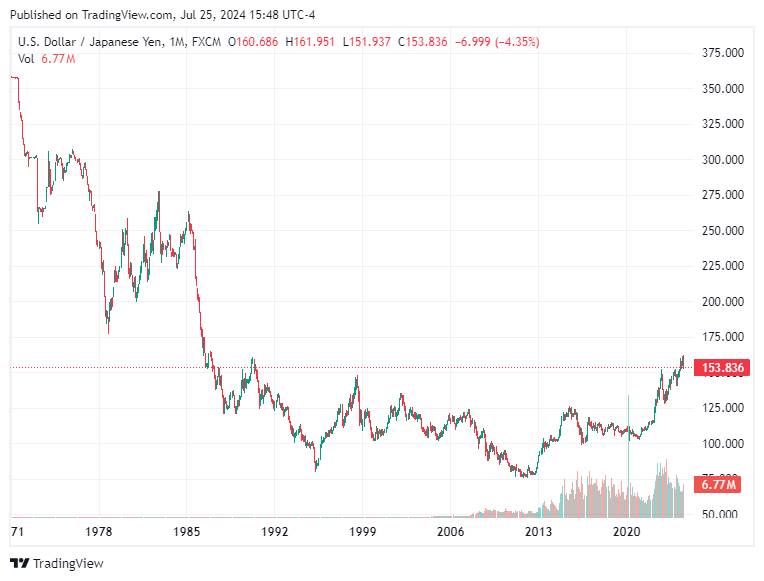Japanese Yen Surges To Nearly Three-Month High
Yen Surges to Nearly Three-Month High Amid Anticipations of BOJ Rate Hike.

Disclaimer: The information contained in this article is for general informational purposes only. It is not intended as professional financial advice and should not be construed as such. Always seek the advice of a qualified financial advisor with any questions you may have regarding financial decisions.
Real-time information is available daily at https://stockregion.net
On Thursday, the Japanese yen surged to its highest level in nearly three months against the dollar, driven by rising expectations of an imminent rate hike by the Bank of Japan (BOJ). This decision in the currency markets occurred amidst a backdrop where most Asian currencies exhibited flat-to-low ranges. A rout in equity markets kept traders largely averse to risk-driven assets, causing a retreat in the dollar ahead of key economic indicators expected in the coming days.
The Rise of the Yen
The Japanese yen emerged as a notable outlier, rallying to its strongest levels against the dollar in over two months. This rally was influenced by several factors, including the unwinding of carry trades, increased demand for safe-haven assets, and growing anticipation of a potential interest rate hike by the BOJ.
Unwinding Carry Trades: One of the primary drivers of the yen's strength has been the unwinding of carry trades. In such trades, investors borrow in low-yielding currencies like the yen to invest in higher-yielding assets elsewhere. However, as the anticipation of a BOJ rate hike grew stronger, these trades began to unwind, leading to a surge in demand for the yen.
Safe Haven Demand: The yen often benefits from its status as a safe-haven currency during times of market uncertainty. With recent volatility in global equity markets, investors sought refuge in safer assets, further bolstering the yen.
Anticipation of BOJ Rate Hike: Speculation around an impending interest rate hike by the BOJ also played a crucial role. With signs of resilience in the Japanese economy, the market began to price in the likelihood of a 10 basis point hike in the upcoming BOJ meeting.
The USD/JPY pair dropped by 1% to 152.38 yen, reaching its lowest level since early May. Initial gains in the yen were sparked by suspected currency market interventions by the Japanese government earlier in July. These interventions squeezed short positions on the yen, fueling an extended rally beyond the apparent government interference.
Asian Market Trends
While the yen surged, most other Asian currencies remained subdued. Concerns over China's economic outlook and actions by the People's Bank of China (PBOC) weighed heavily on sentiment. The Chinese yuan struggled, with the USD/CNY pair hovering around an eight-month high. Persistent worries about a slowing economic recovery in China were exacerbated by surprise interest rate cuts by the PBOC. These measures added pressure on the yuan and failed to improve market sentiment towards the Chinese economy.
Australian Dollar: The Australian dollar (AUD/USD) pair saw a decline, sinking 0.4% to a near three-month low. The currency was heavily influenced by its economic ties to China, and concerns over China's slowdown negatively impacted it.
New Zealand Dollar: Similarly, the New Zealand dollar (NZD/USD) pair lost 0.2%, reflecting broader regional apprehensions and economic uncertainties.
South Korean Won: The South Korean won (USD/KRW) rose by 0.4%, with sentiment towards the country dented by weaker-than-expected GDP data for the second quarter.
Singapore Dollar and Indian Rupee: The Singapore dollar (USD/SGD) remained relatively stable amid some safe-haven trades, while the Indian rupee (USD/INR) hovered just below a record high of over 83.8 rupees, reflecting ongoing pressures.
The Dollar’s Performance
The dollar index and dollar index futures both fell slightly during Asian trading hours, extending an overnight decline. This decline was driven by increasing confidence that the Federal Reserve (Fed) might cut interest rates in September. The anticipation of key economic data releases added another layer of complexity to the market dynamics:
GDP and PCE Data: Gross Domestic Product (GDP) data for the second quarter, due later on Thursday, and Personal Consumption Expenditures (PCE) price index data, due on Friday, are expected to provide more cues on potential rate cuts by the Fed.
Fed Meeting: The Fed is also set to meet next week and is widely expected to keep interest rates steady while signaling a potential rate cut in September. Dovish rhetoric from Fed officials in recent weeks has further supported this expectation.
Despite the weaker dollar and prospects of lower U.S. interest rates, broader Asian currencies did not experience relief. Risk appetite remained largely subdued, influenced by persistent concerns over the global economic outlook and regional economic challenges. From anticipated rate hikes by the BOJ to broader concerns over China's economic health and upcoming key economic data from the United States, the financial landscape remains intricate and dynamic.
As the market watches closely for further developments, particularly the outcomes of central bank meetings and economic data releases, the volatility and shifts witnessed in recent days may continue to shape trading strategies and currency valuations.
Disclaimer: The information in this article is based on current events and market conditions, which can change rapidly. It is not intended as professional financial advice. Always consult with a qualified financial advisor or other professional for specific financial guidance.
Real-time information is available daily at https://stockregion.net


